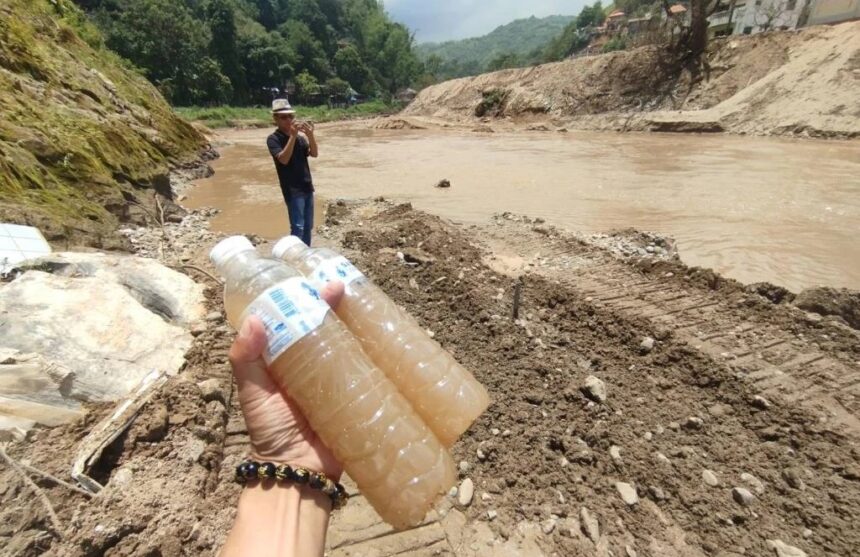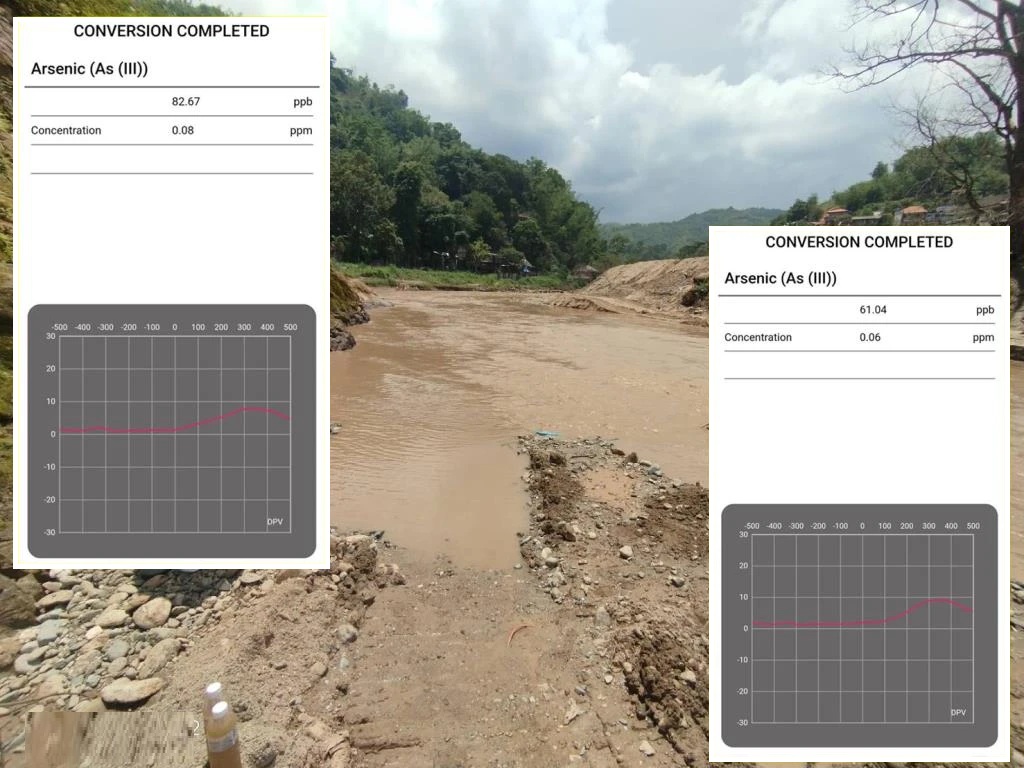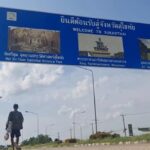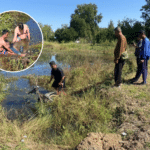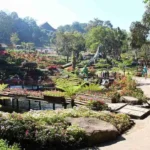CHIANG RAI – Worried about water quality, locals in Mae Sai spent their own money to buy water testing kits. They checked samples from the Sai River and found arsenic levels far above the safe limit. This led to concern across the community.
The Sai River, which forms part of the border between Thailand and Myanmar, has looked unusually cloudy for weeks. On some days, the water turned an orange shade like iced tea, despite no rainfall upstream in Myanmar’s Shan State.
The colour returned to normal, but concerns lingered. Residents living near the river decided to take matters into their own hands.
They purchased field water test kits and collected samples from two locations: near the headworks at Tham Pha Chom village and at the Thai-Myanmar Friendship Bridge.
The results showed arsenic levels of 0.08 and 0.06 milligrams per litre—much higher than the safe standard of 0.01 milligrams per litre.
Dr. Suebskul Kitchanukorn from Mae Fah Luang University’s School of Social Innovation said more people should test their water. He explained that easy-to-use testing kits are now widely available and reliable. Checking water quality should be a regular habit to protect public health.
Officials plan to hold a meeting at Chiang Rai’s provincial hall at 10 a.m. on June 9th, inviting agencies, organizations, and local representatives. They want to provide clear information and address growing concerns. In the past, updates on river water quality in the Kok, Sai, Ruak, and Mekong rivers have sometimes been inconsistent.
This has left many residents worried and confused about whether their water is safe to use. The upcoming meeting aims to give everyone the latest facts and help restore trust in the area’s water supply.
Academics Urge Government to Act on Toxic Rivers
Meanwhile, a group of academics have called on Deputy Interior Minister Teerarat Samretvanich to step up efforts to solve the toxic contamination in Chiang Rai’s rivers from Wa State mines. They say the response so far has been slow, reactive, and lacks determination.
Dr. Suebsakul Kitnugul, a lecturer at Mae Fah Luang University’s School of Social Innovation, sent an open letter to Teerarat. He leads the team tackling water quality issues in the Kok and Sai rivers. The letter points out gaps in current actions and urges clear, transparent communication and decisive steps.
So far, the government has set up four rapid test centres to check water quality in Chiang Mai and Chiang Rai. Another meeting is scheduled for June 9. Dr. Suebsakul offers these observations and suggestions:
- The government hasn’t shown a clear commitment to solving the root of the problem, which is the mining operations upstream in the Kok, Sai, and Ruak rivers. There’s no solid plan to stop the spread of toxic substances. Building silt dams helps a bit, but the real solution is to permanently close the mines.
- The focus remains on the Kok River, even though high levels of heavy metals have been found in the Kok, Sai, Ruak, and Mekong rivers. No proper action has started for the Sai and Mekong. The Ruak River hasn’t been tested for heavy metals at all, even though its water is used for both farming and tap water production.
- Government communication with the public is inconsistent and unclear. Mixed messages have left people confused and unsure whether the water, fish, or river is safe.
- The government controls most information about cross-border risks and the detection of heavy metals. Other groups, including universities, could help with testing, but data and testing plans are rarely shared openly. This lack of transparency makes it hard for the public to get accurate information.
The local water quality centre plays a key role, linking local data to national policy decisions. Still, Teerarat faces two main challenges as director: the slow, risk-averse bureaucracy, and a top-down approach that doesn’t always match what’s happening on the ground.
Dr. Suebsakul remains hopeful, given Teerarat’s experience. His key recommendations include:
- Shut down upstream mines permanently, instead of just upgrading them. This is the only way to truly stop toxic leaks. If mining companies cared about the environment and public health, they would have acted already. Many believe Chinese investors prefer Myanmar for mining because regulations are weaker there, letting them avoid responsibility for environmental damage.
- Track the supply chain for minerals like lead and manganese that are regularly imported through Mae Sai. Knowing which companies are involved helps trace the source and hold businesses accountable for environmental and human rights impacts.
- Publish a full list of all mining operations and companies so the public can see if the government has enough data to negotiate with China, Myanmar, and armed ethnic groups in mining areas.
- Assess and compensate those already affected, including riverside restaurant owners in Chiang Mai and Chiang Rai who lost business, tourism operators in Ban Ruammitr, and fishers who can’t sell or catch fish due to health warnings.
- Expand heavy metal testing in water and sediments to all risky areas, especially the Ruak River (a main water source) and the Mekong near Chiang Khong and Wiang Kaen. This will show how far contamination has spread.
- Make government testing plans and results public. Share detailed data on water, sediments, food chains, and health impacts so everyone can access the facts. Agencies involved include the Chiang Mai Office of Environment and Pollution Control, provincial public health offices, agricultural and fisheries departments, and local water authorities.
- Set up a local centre for heavy metal testing in Chiang Rai. Right now, samples must go to labs in Chiang Mai or Bangkok, causing long delays. Local universities could run these test centres.
- Improve government messaging. Speak plainly and clearly about risks so people know if it’s safe to eat fish or use river water for farming or drinking.
- Promote environmental science among citizens. The government should respect people’s right to know and give them access to basic water testing tools and training. Local authorities should be able to run their water monitoring using test kits, and schools should teach about cross-border pollution and heavy metals.
- Encourage public involvement. People should have a real say in how the government responds to cross-border pollution, since it affects their daily lives.
These steps would build trust and help communities protect their health and way of life.




